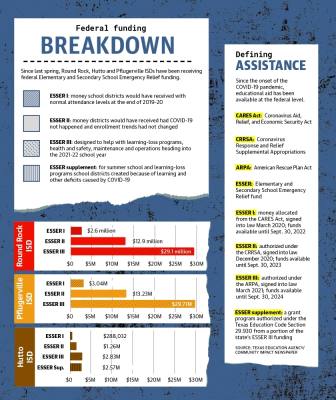During the 2020-21 school year, Round Rock and Pflugerville ISDs saw a decline from the previous year, with student enrollment numbers at both districts down 5.2% and 3.6%, respectively.
With fewer students filling seats at campuses, daily revenue from attendance numbers went down, according to information from local districts.
Now, staff at all three districts said they are having to adjust their fiscal year budgets to reassess spending for the year ahead.
In-depth planning centered on federal relief through the American Rescue Plan Act, or ARPA, has factored heavily into financial preparations for the coming school year.
Although it is still unclear when local district budget planning will be able to resume without significant considerations regarding the pandemic, Pflugerville ISD Chief Financial Officer Ed Ramos said allowing in-person learning in the 2021-22 school year will help.
“We won’t know it until October, when we do our student enrollment snapshot count,” Ramos said. “That’s when we’ll really have a good picture of are we as school districts recovering from this pandemic or not.”
Financial relief
Part of a district’s funding is based on attendance; a certain amount is allocated per student counted present in person or virtually for the 2020-21 school year.
To adjust for virtual learning, Texas had to temporarily change the rules for how attendance was taken, said Robert Sormani, Hutto ISD associate superintendent of instruction and innovation.
Students learning virtually could be counted present if they participated in an educational activity for their class, such as submitting assignments and meeting with their teacher by video or phone call.
“In the normal rule book, if a kid’s not at school, you don’t get any money for that,” RRISD Chief Financial Officer Kenneth Adix said.
Through the first of three rounds of funds from the Elementary and Secondary School Emergency Relief fund, school districts were given money in spring 2020 that they would have received based on normal attendance levels, he said.
The ESSER fund was allocated from money established in the Coronavirus Aid, Relief and Economic Security Act, according to the Office of Elementary and Secondary Education website.
In its first iteration, more than $1.157 billion in ESSER funding was granted to Texas school districts, and it was intended to be used as a response to COVID-19 through preparing for and responding to the pandemic.
Requirements on spending for ESSER II and III are focused more on safely reopening schools and addressing the impact of the pandemic on students.
Allocations of ESSER I, II and III to Texas school districts have been largely based on how much funding each ISD normally receives from Title I funding, according to the Texas Education Agency.
The federal ESSER money has helped local districts due to state regulations that tie attendance to funding.
Lower enrollment numbers in the 2020-21 school year for RRISD and PfISD meant less money received from the state for attendance. According to the TEA, RRISD had a total enrollment of 48,302 students for the 2020-21 year, a 5.2% decrease from the previous year’s 50,953 students. PfISD’s enrollment was down 3.65%, going from 26,400 to 25,436 in 2020-21.
As with the first round of federal ESSER allocations, ESSER II funding will benefit districts for the 2020-21 school year and allocate money they would have received had COVID-19 not negatively altered enrollment trends, Adix said.
While the federal relief was not distributed based on in-person attendance at each district campus, he said, ESSER II brought RRISD closer to where it would have been financially.
The latest round of funding in progress from the American Rescue Plan Act is called ESSER III, and all three districts have been granted an allocation.
RRISD officials expect to receive a total of $29.1 million with half planned to be spent in 2021-22 and the rest available through the 2022-23 school year, Adix said.
PfISD anticipates $29.7 million in ESSER III money. Ramos said the district has until September 2023 to use its ESSER II money and until September 2024 to use funds from ESSER III.
HISD Chief Financial Officer Glenn Graham said the district is eligible for around $2.8 million in ESSER III money. At the time of publication, HISD had only received and used the $288,032 in ESSER I money to invest in technology for students learning virtually, he said.
Moving fiscally forward
Looking toward a new school year, local district staff have said they are hopeful to see student enrollment numbers grow.
Enrollment at HISD has remained steady, increasing from 8,130 in 2019-20 to 8,421 in 2020-21.
District information shows HISD projects 10% student growth for 2021-22—an additional 850 students—from the previous year.
Evidence of that growth has begun to materialize. In June, an additional 350 students enrolled at HISD for the 2021-22 school year.
Ramos said PfISD has seen an increase in prekindergarten and kindergarten registrations. He said that increase in enrollment can be seen as a positive sign for the district.
RRISD is projecting enrollment at 50,461 students in 2021-22, which is an increase of more than 2,000 from the previous year. PfISD projects enrollment at 26,312 for the 2021-22 school year, which is close to its prepandemic numbers.
The biggest concern of each school district chief financial officer is having to prepare for how many students will actually show up to campus come August, Adix said.
If we missed it by a thousand students, ... that’s $8 million of money that we thought we would get from a revenue that we’re not going to get,” he said.
Missing projected numbers also impacts staffing because more teachers are hired in anticipation of growth.
PfISD Chief Communications Officer Tamra Spence said during the uncertainty of the last school year, many parents across the state pulled their kids out of public schools. Going back to in-person learning in 2021-22, districts are anticipating a return of some of those students.
“I think the state is kind of waiting, hoping that this fall, when things are more back to normal, that we’re going to see a large influx of kids in districts across the state that we didn’t really know where they were last year,” Spence said.







